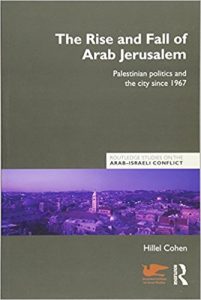The Rise and Fall of Arab Jerusalem,

Palestinian politics and the city since 1967
Review essay by Simon A. Waldman, Kings College London, reviewed jointly with The Shift Journal of International and Global Studies, 2011. (London: Routledge. 2011)
“Research fellow at the Jerusalem Institute for Israel Studies, Hillel Cohen’s The Rise and Fall of Arab Jerusalem: Palestinian politics and the city since 1967 makes an interesting and absorbing read. Incidentally, Cohen’s take on the nature of the Israeli-Palestinian conflict is that the Palestinian armed struggle is a conflict against an occupying power but not a classic anti-colonial struggle because the dispute is between two peoples over the same land (p. 42).
“Cohen’s work focuses on East Jerusalem and the political actions and discourse of East Jerusalemites. It is a broad study encompassing themes such as the work of Jerusalem NGOs in matters such as (1) human rights and protection of Muslim structures in the city, as well as their relationship with residents and the Palestinian Authority (pp.81-85), (2) joint Israeli-Palestinian activities against the Israeli establishment and occupation from 1967 to present day (pp. 91-102), (3) the route of the separation barrier (pp 98-100), and (4) urban planning and house demolitions (pp. 101-4). In constructing his analytical narrative, Cohen makes use of both his “intimate knowledge” of his “hometown” and (perhaps more importantly) “hundreds” of meetings with Palestinians in East Jerusalem (p. X).”
“He also uses a vast array of reports from the Hebrew and Arabic press as well as Israeli and Palestinian NGO reports and think tank releases and publications. What Cohen argues is that despite there being several political trends among East Jerusalemites, what unites them is a desire to maintain Arab life and preserve the city’s Arab nature (p.133). Israel’s increasing dominance in the city, through the expansion of the municipal boundaries and Israeli unilateral moves to accelerate Jewish building while disconnecting Palestinian neighborhoods from the city, only increases hostility towards Israel and does not lead to a Palestinian acceptance of the verdict (pp. 134-5).
“An underlying theme present in Cohen’s analysis is the centrality of Jerusalem in the Palestinian national movement. He calls it a “capital in waiting” between 1948 and 1967 and a “capital in the making” between 1967 and 1993. The implication is that the Palestinian national movement consistently considers Jerusalem its future capital. (p. 3-12). Cohen also recounts the history of the city from 1917 to 1948, recalling that under the Ottoman period, the city was the capital of an independent district or Sancak and was “directly accountable to the government in Istanbul,” an expression of its “unique status and importance in the Journal of International and Global Studies 76 empire” (p.1). However, this is not quite accurate. First, the name of the Ottoman capital was Constantinople and not Istanbul. The city’s name was changed only after the founding of the Turkish Republic, where Ankara was made Capital. Second, the Sancak or mutasarriflik (subgovernate) of Jerusalem was only made directly answerable to Constantinople during the end of the nineteenth century not necessarily because of its important and unique status, but also for other reasons such as increased foreign interest in the city as well as it being part of a general Ottoman trend of centralization. Nevertheless, this does not detract significantly from Cohen’s view that Jerusalem plays a historic and, in present day, a central role in Palestinian politics.” (more…)
